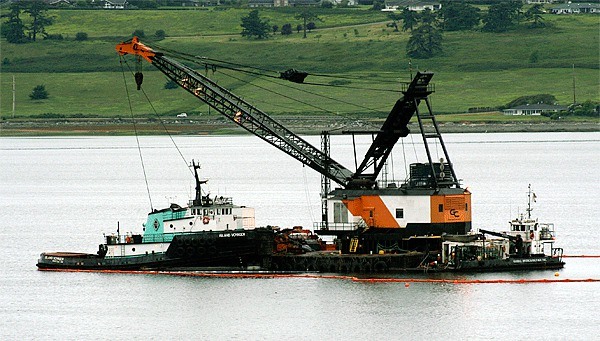A 128-foot derelict crab boat that sank in Penn Cove more than two weeks ago could be raised today, according to officials with the state Department of Ecology.
The first of two large cranes that will be used to pick up the vessel arrived Monday. Dive crews worked through the holiday weekend and into this week to prepare it for lifting.
As of press time Tuesday, however, state Department of Ecology spokesman Curt Hart said there were still a lot of moving pieces and unknowns, which made a Wednesday start date a best-case scenario.
“The best I can give you is that the soonest it will happen is tomorrow,” Hart said.
The Deep Sea had been anchored illegally for months in Penn Cove, west of the Coupeville Wharf and just outside the mussel rafts, when the vessel caught fire and sank May 13.
While thousands of gallons of fuel were siphoned from the ship’s tanks — there was supposed to be less than 100 gallons aboard — an estimated 1,500 more gallons were recovered from the surface with special skimming boats and absorbent pads.
The leaking resulted in the closure of private and commercial shellfish harvesting, beginning May 15.
It will remain in effect until the petroleum sheen has been absent on the surface for a period of one week and tests show shellfish are safe for consumption.
The Department of Ecology has completed an environmental assessment, which will help state and federal responders take measures to protect water quality, nearby shellfish operations, public beaches and important habitat areas during the upcoming removal operations.
It determined that Penn Cove supports large populations of mussels, that their spawning cycle is at its peak and larvae are particularly susceptible to the toxic effects of oil.
It also found the cove is a major seabird concentration area that’s home to marbled murrelets, which are endangered, along with bald eagles, peregrine falcons and blue herons. Harbor seal haul-outs are in the vicinity and the cove is visited by southern resident orcas.
Salt marshes that support juvenile salmon are located throughout the area. Penn Cove shorelines and eelgrass beds can support extensive forage fish spawning.
Despite its rich ecology, there have been no reports of affected wildlife or wide-scale environmental damage. That’s largely due to the quick efforts of the U.S. Coast Guard, according to Richard Walker, the on-scene coordinator with the state Department of Ecology.
“They really are the heroes of this story,” Walker said.
“They saved this cove,” he said.
Had the federal agency not acted quickly — hiring a containment firm and dive company — after the boat first caught fire and sank, the thousands of gallons that leaked and were recovered would have spread uncontrolled through Penn Cove, causing environmental damage that may have been felt for years to come, he said.
Walker said the vessel is continuing to leak small amounts of oil and that small amounts are escaping the floating boom that remains around the sunken vessel.
The amounts are so small that it’s deemed “unrecoverable,” but because the boat presents an ongoing source of pollution, the agency and its contractor, Global Diving & Salvage Inc., are working hard to remove it.
The state Department of Natural Resources, the Coast Guard and the Island County Department of Emergency Management are also involved in the effort.
Walker said preparations to remove the vessel have been time consuming and difficult. Part of the task involves hollowing out trenches beneath the Deep Sea for the chains that will hoist it to the surface. Divers have encountered debris, such as a hatch cover, under the boat that has slowed progress.
Once everything is ready, a second and larger crane will be called in from Seattle. Both will first right the vessel, which is laying on its side, before hoisting it about surface level.
The whole thing can’t be pulled out at once due to the weight of the water inside so pumps will be used to empty it. The vessel may also be patched for towing or put on a barge. The entire process could take as much as a day, Walker said.
“It’s not going to be quickly,” he said. “It’s going to be many hours, inch by inch.”
According to Hart, the vessel will be removed and disposed of at an undetermined location. While it will likely be at a yard in Seattle, that’s being handled by the Department of Natural Resources and no contracts have yet been signed.



